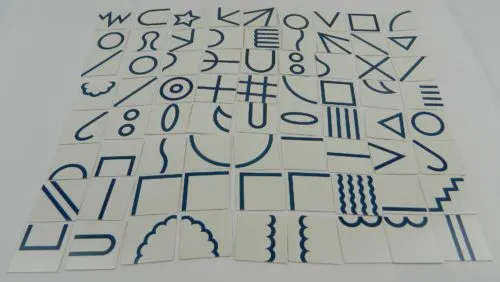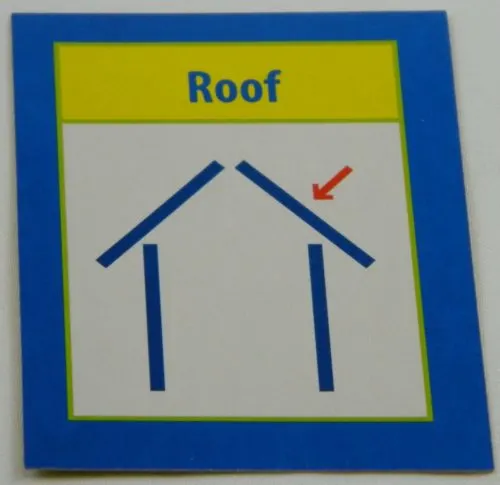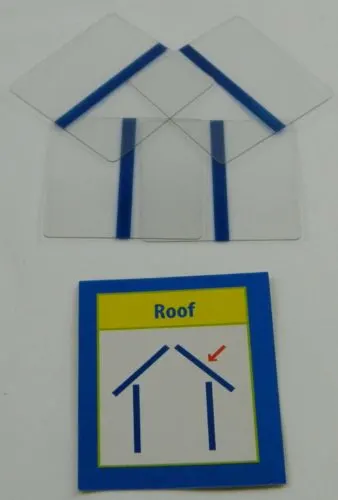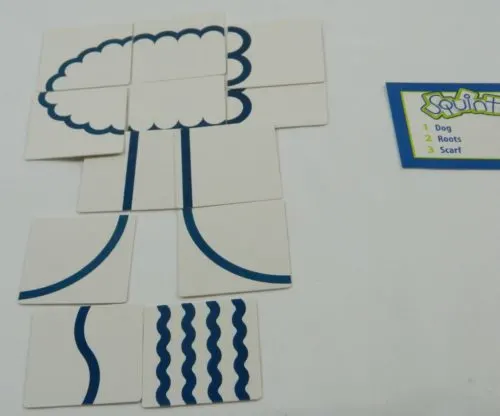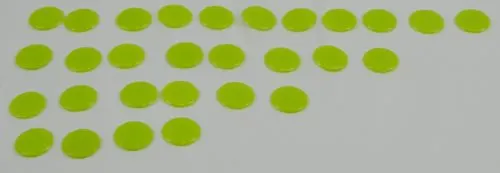Arguably one of the most popular board games ever created was Pictionary. The idea of being given a word/object/idea that you have to draw for other people to guess has been utilized in so many games that it has spawned its own genre of games. I have always had mixed feelings towards this genre. These games can be fun and they are simple enough that anyone can play them. The problem is that many of them rely on the players actually being good at drawing which is something that doesn’t really describe anyone in my gaming group. Because of this my group generally prefers games that give players a little assistance with the drawing aspect of the game. Today I am taking a look at Squint and Squint Junior which have an interesting take on your typical drawing game. Instead of drawing things yourself, you use cards that have various shapes on them in order to create your picture. Squint and Squint Junior are an interesting and fun little twist on the drawing genre, even if they can be quite hard at times.
How to Play Squint and Squint Junior
For this review I am looking at both Squint and Squint Junior. The rules for both games are very similar. The rules below are for Squint with notes of any differences for Squint Junior.
Setup
- Spread out all of the Shape Cards on the table so that they can all be seen.
- Choose a player to be the first builder. Give the card tray and the die to the builder.
- Decide which side of the cards that you will use. There is no difficulty difference between the sides, but players should use the same side of the cards for the entire game.
- The timer is passed to the player to the left of the builder.
Playing the Game
The game is played over a number of rounds with each player getting one turn as the builder each round. The number of rounds in the game depends on the number of players:
- 3-4 players – 4 rounds (3 rounds in Squint Junior)
- 5-6 players – 3 rounds (2 rounds in Squint Junior)
- 7-8 players – 2 rounds (1 round in Squint Junior)
To begin your turn as a builder you will roll the die. The number you roll will determine which object that you will have to try to build with the Shape Cards. It will also determine how many points that you can potentially score as higher numbers are harder to guess. You will draw a card from the tray and read the object that corresponds to the number you rolled.
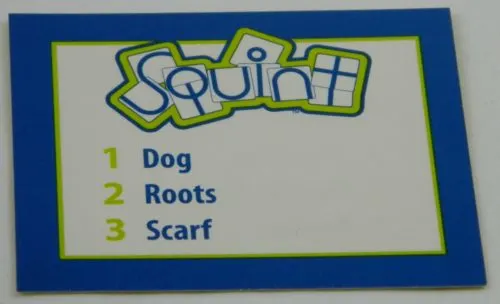
The person that drew this card rolled a two. Therefore they will have to try and draw “roots” with the shape cards.
Squint Junior does not include a die as there is only one object on each card. You will try to make the object shown on the card.
- This player has drawn a Squint Junior card that has a picture of a roof. The player can choose to either follow the picture shown on the card, or they can make their own design.
- This player followed the design on the card to recreate the roof.
When you are ready, the player to your left will turn over the timer.
You will then have until the timer runs out to try and recreate the object from the card. To do this you will use the Shape Cards on the table to form the shape of the object that you are trying to get the other players to guess.
While forming the object you must follow these rules:
- You can use as many or as few Shape Cards as you want.
- You may tell the other players what is the front side of the object that you are creating. In Squint Junior you can tell the other players what is the top and bottom of the picture.
- You may use the backside of Shape Cards to block out certain parts of another Shape Card.
- You may move or animate the object that you are creating. The cards must remain on the table as you do this though.
- You may point to a specific area of your picture and respond with yes or no. In Squint Junior you can also say “hot” or “cold”. Builders cannot otherwise speak, use hand gestures, or give other clues.
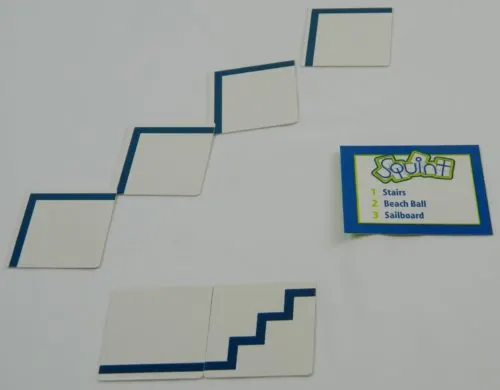
For this round the player had to create “stairs”. Here are two different ways the player could create the object with the shape cards.
All of the players can begin guessing at any time. They may guess as many times as they want with no punishment for incorrect guesses. If one of the players guess correctly before the timer runs out, the player who guessed correctly as well as the builder will receive chips equal to the number that was rolled to begin the turn. In Squint Junior both players will receive one chip. If time runs out, no players will receive chips for the card.
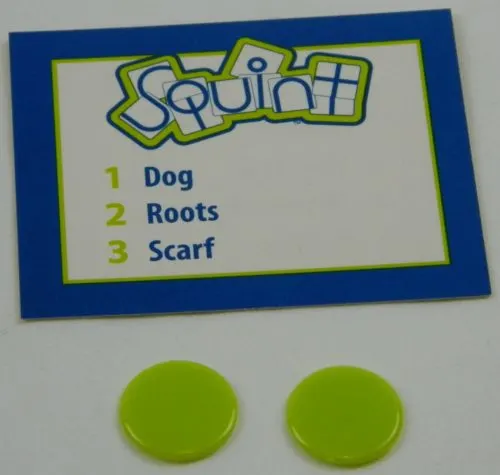
As one of the players correctly guessed “roots” the current player and the correct guesser will both receive two chips.
Play will then pass to the next player clockwise/left. A round ends when all of the players have had one turn to be the builder.
End of Game
The game ends when all of the rounds have been played.
Players will count up how many chips they acquired during the game. The player who acquired the most chips will win the game.
If there is a tie, the player to the left of the last builder will be the builder for the tie breaker. If this player is one of the tied players the role will pass to the next player clockwise. The first tied player to guess the object will win the game.
Variant Games
Squint Light – Instead of rolling the die, always play the level 1 words.
Squint Challenge – Instead of rolling the die, always play either the level 2 or 3 words.
Progressive Squint – Players will begin their turns creating the level 1 word. If the word is correctly guessed, the player can start the level 2 word if there is still time. If there is still time, the player can also try level 3 if the first two levels are guessed. When times runs out the players will earn chips based on who guessed each level correctly.
Squint Junior Light – The timer is not used so the builder has as much time as they need.
Squint Junior Expert – The players can’t look at the pictures shown on the cards.
My Thoughts on Squint and Squint Junior
With the popularity of the drawing genre of board games, there have been many different games that have tried to create their own variation of the formula. Most drawing games stick pretty close to the typical formula. There are the occasional drawing games that take the idea in interesting new directions though. As someone who would not consider themselves to be a particularly good artist, I have always gravitated towards games that give players a helping hand with the drawing or tweak the formula enough that your drawing skills aren’t as important. In the past we have looked at quite a few different drawing games that follow this formula which includes The Cat Game, Cranium Scribblish, Luck of the Draw, Pictomania, and Starlink. I would say that Squint and Squint Junior fit right in with these other games.
I would say that Squint is a drawing game despite players not drawing a single line in the entire game. Basically players are given a set of cards which feature various shapes and symbols. A player is then given something that they will have to create for the other players. The player has to use the various shape cards in order to create the object that they were given for the current round. Instead of being able to draw whatever you want, players need to work with the various shapes that they are given to give an approximation of the object. As you usually won’t have the exact shapes that you want to use, you sometimes need to be more abstract with what you ultimately end up creating.
I have played a lot of different drawing games in the past, and I can’t recall playing one quite like Squint. In a way it feels like a drawing game, and at the same time it doesn’t. Instead of emphasizing player’s drawing skills, the game seems to reward quick thinking as well as being able to think outside of the box. Between the shapes that you have to use and the limited amount of time to create your “drawing”, you aren’t going to be able to make a perfect drawing or even get close to what you want to create. You need to cut corners and figure out what are the most important elements in order to get the other players to guess correctly. Artistic talent can help in some ways, but the key to doing well in the game seems to be more about being able to think of creative ways of using the various shapes.
This was an interesting twist on your typical drawing game, and I think it makes Squint a pretty enjoyable game. Now the game might not appeal to all fans of the genre. Those that like drawing games because they emphasize the player’s drawing skills will likely be disappointed by the game. Those that like to think creatively and outside of the box will likely enjoy the game though. I found trying to use the various shape cards to create objects to be pretty enjoyable. It is quite satisfying when you are able to get the other players to guess a pretty challenging word while only using shape cards. The game can also be pretty funny at times as the artist and guessers can be on totally different wavelengths.
Outside of the gameplay being pretty fun, Squint also succeeds at being a game that pretty much anyone can play. Anyone who has ever played a drawing game before should be able to jump in pretty quickly. Outside of a few rules regarding how you can use the shape cards, the gameplay is pretty simple. Get a word that you have to create and use the shape cards to create it. I think the game could be taught to new players within a couple minutes. The main game has a recommended age of 12+, while the Junior version has a recommended age of 8+. I personally would say that the main game is probably closer to Squint Junior’s recommended age. Outside of being able to read the cards and understand what they are supposed to create, I don’t think children will have too many issues with understanding the rules. The game is also simple enough that the game shouldn’t be too overwhelming for people that don’t usually play many board games.
Because of the simplicity and how quick the rounds play, I would also say that Squint plays pretty quickly. The length of the game will somewhat depend on the number of players as more players will mean that more rounds will have to be played. If you are playing with around four players though, I think most games will only take around 20-30 minutes. I think the game could still work if it was a little longer, but I think the length is pretty good. The shorter length means Squint doesn’t overstay its welcome, and it allows the game to work pretty well as a filler game. It should work well if you don’t have a lot of time, or you want something to play between longer/more complicated games.
I genuinely enjoyed playing Squint. There is one somewhat significant issue with the game though. While the gameplay is fun, I think the game was more difficult than it needed to be. By this I mean that it is hard to actually get another player to guess what you are trying to create. All of the cards in the original game are divided into three different difficulty levels. The higher numbers are supposed to be harder and for the most part they are. There are occasional cards where you can make an argument that the higher level words are actually easier to create though. Based on our group, I would say that the level one cards were guessed correctly probably 50-75% of the time. When we got to the level two and three cards this percentage dived as we rarely were able to complete them. I think this can be attributed to two things.
First I think the game just overestimates how good players will be at the game. There are things that are pretty easy to create with the cards, and there are things that the shapes don’t work all that well for. The problem is the game too often relies on words that fall into the second category. To succeed with these hard words you need to really scour the shape cards to find the exact ones that you need, and you need to use them in creative ways. Maybe more artistic players will have more success, but our group for sure had issues with a lot of the objects that we had to create.
The more significant problem is simply that the game just doesn’t give you enough time. I tested the sand timer that came with my copy of the game, and it seemed to be around 45-50 seconds. In my opinion that is far from enough time. The game really should have given you at least twice that amount of time. Time is so key to the game as you will spend at least half of your time just looking for the shape cards that you want to use. With so little time you can’t really do anything to add details to your design, and you also need to find your desired shape cards quickly. There were far too many times in the game that players knew what they wanted to create, but they just didn’t have enough time to get it done. This is even worse for the level two and three words. Because of this I would highly recommend that you turn the timer over at least twice before ending a player’s turn.
Because of the game’s difficulty and the fact that all of the cards are not equal, to get the most enjoyment out of Squint you can’t take it too serious. Some players will be better at the game than others, but the ultimate winner will also rely on some luck as well. Between getting objects that are easier to draw and are worth more points, to finding the shape cards they need quickly; anyone can win the game if they have more luck than the other players. The game is not meant to be taken that serious to begin with. The winner is ultimately not that important to the game. What is important is just having a good time with the people that you are playing with.
It is usually pretty rare when I review more than one game in a review. In the case of Squint and Squint Junior though I felt it was warranted as the two games are very similar. There are only a couple of minor differences which were mostly done in order to make the game easier to play for children. The biggest difference is just the fact that Squint Junior actually includes an example of a picture you can create for the word on the card. This was obviously done to make the game easier for children. I think this was a good decision for younger children, but it kind of ruins the game for everyone else. Basically when you are given an example, there really isn’t any reason to differentiate from it. This makes Squint Junior an exercise of finding the right shape cards and arranging them properly. It eliminates much of the creativity of trying to figure out how to create the object yourself.
I personally thought the original Squint game was better than Junior. This is mostly because I just didn’t find it all that compelling just trying to recreate a picture as quick as possible. If you have younger children or think that sounds more interesting than coming up with your own design though, you may prefer Squint Junior. For the most part I don’t know if it really pays to own both versions of the game as they are mostly the same. The only reason to own both is if you want to use the cards from one version of the game as additional cards for the other game. Therefore I would probably only recommend picking up both games if you can get a good deal on them.
Speaking of the cards, I thought the components for both games were pretty good. Squint includes 72 shape cards and 168 squint cards while the Junior version has 42 shape cards and 168 squint cards. While I would always like more cards, there isn’t much that you can complain about when it comes to the number of cards included in the game. You should be able to play a lot of games before you ever have to worry about having to reuse a card especially since the cards from the original game are double-sided. What I found interesting about the two games is that their shape cards are actually a little different. The original game’s cards are opaque which allows you to use the back of cards to cover up parts of the shape cards. Meanwhile the Junior version includes transparent cards which allows you to overlap cards. I would say that both types of cards have their own benefits. Other than the cards the other components are quite solid. The game should also be commended for coming in a small box where it doesn’t waste much space.
Should You Buy Squint or Squint Junior?
Squint and Squint Junior are interesting little games. In some ways they are drawing games, but they take a really interesting twist on the formula. Instead of actually drawing objects, you need to use shape cards in order to form your design. This is a pretty interesting idea that can also be pretty fun. While it still requires some artistic talent, the game also relies on creative use of the shapes as well as outside the box thinking. The game is easy to play and plays pretty quickly. The biggest fault with Squint is just that the game is pretty hard. Between having to create objects that are pretty hard to make with basic shapes and the time limit, it is hard to get enough of your drawing finished that another player can guess it in time. Thus to really enjoy the game, you really need to not worry too much about who ultimately wins.
My recommendation for Squint and Squint Junior mostly comes down to your thoughts on the premise behind the game. If neither sound all that interesting, I don’t think you will enjoy them. Those that think the game sounds fun though should enjoy it. Whether you should pick up Squint or Squint Junior depends on whether you plan on playing with children or want a guide to fall back on if you don’t know what to otherwise make. I think most people will prefer Squint, but if you have young children it might be worth checking out Squint Junior. If you can get the games for cheap, it may be worth picking up both in order to have more cards for the game.
Buy Squint or Squint Junior online: Amazon (Second Edition, Third Edition
, Squint Junior
), Ebay (Squint
, Squint Junior
). Any purchases made through these links (including other products) help keep Geeky Hobbies running. Thank you for your support.


